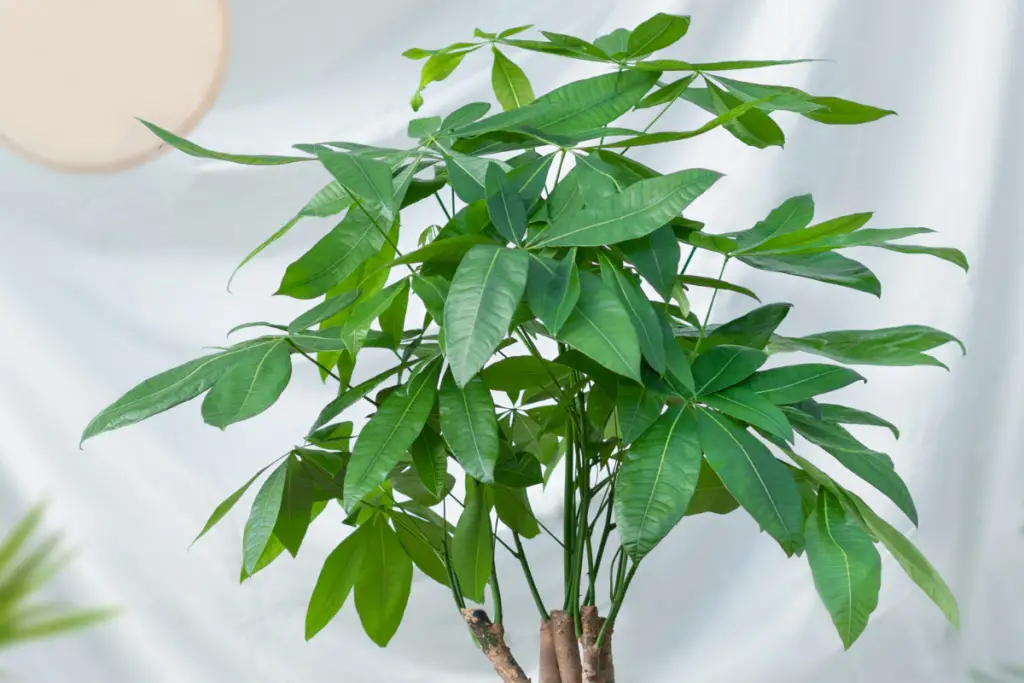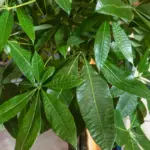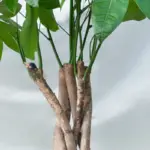Money Trees, also known as Pachira Aquatica, are popular houseplants that are easy to care for and bring good luck and fortune to their owners.
However, despite their hardiness, Money Trees can sometimes fall victim to various problems that can cause them to wilt, turn yellow, or even die.
If your Money Tree is showing signs of distress, it’s important to act quickly to save it.
The causes of a dying Money Tree can be numerous, from overwatering to pests and diseases. To revive a dying Money Tree, it is crucial to identify the root cause of the problem and take appropriate action.
While some issues can be resolved with simple adjustments to watering and lighting, others may require more advanced care or even the removal of damaged parts of the plant.
In this article, we will explore the common causes of a dying Money Tree and provide tips on how to revive it.

Table of Contents
Recognizing a Dying Money Tree
If you have a Money Tree (Pachira aquatica) in your home or office, it is important to know how to recognize when it is dying.
Catching the signs early can help you revive the plant and prevent it from dying completely.
In this section, we will discuss the signs of a dying Money Tree, as well as the common diseases and pests that can cause it to wither away.
Signs of a Dying Money Tree
There are several signs that your Money Tree may be dying. Here are some of the most common ones to look out for:
- Yellowing leaves: If the leaves of your Money Tree are turning yellow, it may be a sign of overwatering, underwatering, or exposure to direct sunlight.
- Brown or black spots on leaves: This could be a sign of a fungal or bacterial infection.
- Drooping or wilting leaves: This is a sign of dehydration or root rot.
- Leggy growth: If your Money Tree is growing tall and thin, it may not be getting enough light.
- Shriveling leaves: If the leaves are shriveling up and falling off, it may be a sign of underwatering or low humidity.
Common Diseases and Pests
Money Trees are susceptible to a variety of diseases and pests. Here are some of the most common ones that can cause a Money Tree to die:
- Root rot: This is caused by overwatering and can be identified by a foul smell coming from the soil and black, mushy roots.
- Spider mites: These tiny pests can cause yellowing and wilting leaves, as well as webbing on the plant.
- Mealybugs: These insects look like small white cotton balls and can cause stunted growth and yellowing leaves.
- Scale insects: These pests look like small brown bumps on the leaves and can cause yellowing and wilting.
If you notice any of these signs or pests on your Money Tree, it is important to take action quickly to revive the plant.
Fundamental Care for a Money Tree
Money trees are popular houseplants because they are easy to care for and bring a touch of greenery to any room. However, if not taken care of properly, they can die.
To prevent this from happening, it is important to understand the fundamental care requirements.
Watering Requirements
Watering is the most crucial aspect of caring for a money tree. Overwatering or underwatering can lead to the death of the plant.
Money trees prefer consistently moist soil, but not waterlogged soil. The frequency of watering depends on the environment and the size of the pot. In general, watering once a week is sufficient.
To check if the soil is dry, insert a finger into the soil up to the second knuckle. If the soil feels dry, it is time to water the plant.
When watering, make sure to water thoroughly until water comes out of the drainage holes.
Lighting Conditions
Money trees prefer bright, indirect light. Direct sunlight can damage the leaves and cause them to turn yellow or brown. If the plant is not receiving enough light, the leaves will start to droop.
If the plant is not getting enough light, move it closer to a window or provide artificial light. If the plant is getting too much light, move it away from the window or provide shade.
Temperature and Humidity Needs
Money trees prefer a temperature range of 60-75°F (15-24°C). They can tolerate temperatures as low as 50°F (10°C) and as high as 90°F (32°C).
Money trees also prefer high humidity, similar to their natural tropical habitat. If the air is too dry, the leaves will start to brown and curl. To increase humidity, mist the leaves regularly or use a humidifier.
By understanding and following these fundamental care requirements, you can help ensure that your money tree thrives and does not die.
Reviving a Dying Money Tree
When a Money Tree starts to show signs of dying, it can be a stressful experience for any plant owner. However, with proper care and attention, it is possible to revive a dying Money Tree.
In this section, we will discuss the steps that one can take to revive a dying Money Tree.
Correct Watering Techniques
One of the most common reasons for a Money Tree to die is incorrect watering techniques.
Overwatering or underwatering can cause stress to the plant and lead to its death.
To revive a dying Money Tree, it is important to check the soil moisture level regularly. The soil should be moist but not waterlogged.
If the soil is dry, it is time to water the plant. On the other hand, if the soil is still moist, it is best to wait before watering again.
Improving Light Exposure
Another reason for a Money Tree to die is lack of proper light exposure. Money Trees require bright, indirect light to thrive.
If the plant is not receiving enough light, it can lead to stunted growth and eventually death. To revive a dying Money Tree, it is important to move the plant to a brighter location.
However, direct sunlight can also damage the plant, so it is best to provide filtered light.
Adjusting Temperature and Humidity
Money Trees thrive in warm, humid conditions. If the plant is exposed to extreme temperatures or low humidity levels, it can lead to stress and eventually death.
To revive a dying Money Tree, it is important to maintain a temperature range of 53.6°F and 77°F (12 ° C and 25 ° C).
Additionally, it is important to maintain high humidity levels by misting the plant regularly or using a humidifier.
Treating Diseases and Pests
Diseases and pests can also cause a Money Tree to die. Common pests that affect Money Trees include spider mites, mealybugs, and scale insects.
To revive a dying Money Tree, it is important to identify the pest or disease and treat it accordingly.
This may involve using insecticidal soap or neem oil to control pests or removing infected leaves and treating the plant with a fungicide to control diseases.
By following these steps, it is possible to revive a dying Money Tree and restore it to its former glory.
Preventive Measures for Money Tree Health
To keep your money tree healthy and prevent it from dying, there are several measures you can take. These measures include regular pruning, proper fertilization, and periodic repotting.
Regular Pruning
Pruning your money tree regularly is essential to maintain its health. Pruning helps remove any dead or diseased leaves or branches, which can attract pests and diseases.
It also promotes new growth and helps maintain the tree’s shape.
To prune your money tree, use clean, sharp pruning shears and make clean cuts at a 45-degree angle.
Make sure to remove any branches or leaves that are yellow, brown, or wilted, as these are signs of disease or pest infestation.
Proper Fertilization
Proper fertilization is crucial to the health of your money tree. Fertilizing your tree provides it with essential nutrients that it may not get from the soil.
However, over-fertilizing can harm your tree, so it’s essential to fertilize it correctly.
Use a balanced fertilizer with equal parts nitrogen, phosphorus, and potassium. Fertilize your tree every three months during the growing season, from spring to early fall.
Be sure to follow the manufacturer’s instructions and do not exceed the recommended amount.
- 🌱 PERFECT BLEND OF NUTRIENTS - Give your money tree plants everything they need to grow up healthy! Our 3-1-2 liquid concentrate has all of the essential nutrients that your plants crave.
- 🌱 MIX WITH WATER - Designed to blend with water to provide a single application to use every other watering cycle. 1-2 tsp per 8 cups water.
- 🌱 SUITABLE FOR ALL VARIETIES - You can use our fertilizer on just about any kind of money tree plant. Its great for seedlings and mature plants alike.
- 🌱 SPECIALLY DESIGNED PREMIUM FORMULA - Special blend enables maximum absorption for plant growth and vitality.
- 🌱 DURABLE PACKAGING - This liquid concentrate comes in a sturdy, 8 oz sealed bottle. Store it in a safe, dry place and you can count on it to stay in great condition for a long time to come.
- 🌱 ALWAYS 100% GUARANTEED - Our plant nutrients are made and packaged in the USA to ensure quality. Every purchase is also covered by our 100% Money Back Guarantee for your peace of mi
Prices pulled from the Amazon Product Advertising API on:
Product prices and availability are accurate as of the date/time indicated and are subject to change. Any price and availability information displayed on [relevant Amazon Site(s), as applicable] at the time of purchase will apply to the purchase of this product.
Periodic Repotting
Periodic repotting is necessary to ensure that your money tree has enough space to grow and thrive. Repotting also helps replace the soil, which can become depleted of nutrients over time.
Repot your money tree every two to three years, or when you notice that the roots are starting to grow out of the pot’s drainage holes.
Use a well-draining soil mix, and make sure the pot has drainage holes to prevent overwatering.
By following these preventive measures, you can help keep your money tree healthy and prevent it from dying.
Conclusion
In conclusion, reviving a dying money tree is possible with the right care and attention.
The first step is to identify the cause of the problem, whether it is due to overwatering, underwatering, lack of humidity, or pests.
Once the issue has been identified, the necessary steps can be taken to address it.
It is important to note that prevention is key when it comes to keeping a money tree healthy.
Regularly checking the soil moisture, providing adequate humidity, and avoiding direct sunlight can help prevent many common issues.
Additionally, keeping an eye out for signs of pests or disease and addressing them promptly can help prevent more serious problems down the line.
Overall, with proper care and attention, a dying money tree can be revived and returned to its former glory.
By following the tips and techniques outlined in this article, readers can give their money tree the best chance of thriving for years to come.
- How to Dry Basil Leaves: A Professional Guide
- Is an Avocado a Fruit or Vegetable? Simple Answer and Explanation
- Does Pineapple Have Seeds? Exploring the Anatomy of Pineapples
- Blooming Through Winter: Can I Grow Vegetables Indoors in the Winter?
- What Can You Grow in a Greenhouse All Year Round: A Guide to Year-Round Greenhouse Gardening
- Are Blueberries Blue? Debunking the Myth of Their Color

















